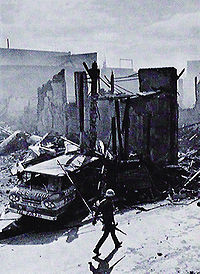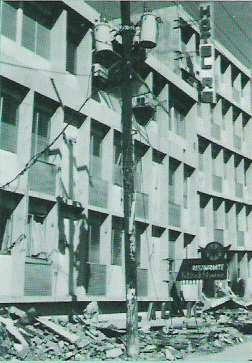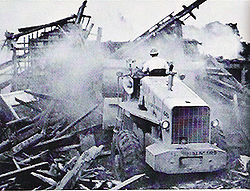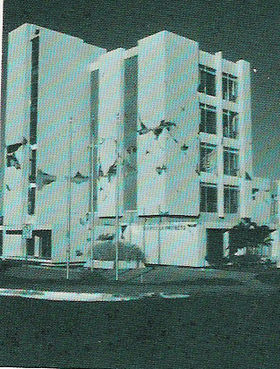
1972 Nicaragua earthquake
Encyclopedia
The 1972 Nicaragua earthquake was an earthquake
that occurred at 12:29 a.m. local time (06:29 UTC) on Saturday, December 23, 1972 near Managua
, the capital of Nicaragua
. It had a magnitude of 6.2 and occurred at a depth of about 5 kilometers beneath the centre of the city. Within an hour after the main shock, two aftershocks, one of magnitude 5.0 and the other 5.2, occurred. The earthquake caused widespread damage, among Managua's residents, 5,000 were killed, 20,000 were injured and over 250,000 were left homeless.
 Managua, which lies on the southern shore of Lake Xolotlan near the western coast of Nicaragua is situated within an active volcanic zone known as the Central American Volcanic Chain. The city has a long history of volcanic and seismic activity which arises from the relative movements of two crustal plates which intersect near the southwestern border of Central America. The Cocos
Managua, which lies on the southern shore of Lake Xolotlan near the western coast of Nicaragua is situated within an active volcanic zone known as the Central American Volcanic Chain. The city has a long history of volcanic and seismic activity which arises from the relative movements of two crustal plates which intersect near the southwestern border of Central America. The Cocos
plate, located east of the East Pacific Rise
, is moving northeastward and is slowly being submerged under the Caribbean plate. The zone of dipping is initiated at the surface of the Middle American Trench, which extends 4 to 5 kilometers deep along the Pacific Coast from Mexico
to Costa Rica
. But rather than a simple crustal movement between the two plates the earthquake was believed to have been caused by a shallow adjustment to geological pressure at the south western corner of the Caribbean plate.
One of the most significant effects geologically of the 1972 Nicaragua earthquake quake was surface faulting. Examination of the fault lines indicated a lateral motion moving in a northeasterly direction and aftershock data has revealed at last one of the faults extends from the surface to a depth of 8 to 10 kilometers beneath the city of Managua.
 The earthquake severely damaged an area of 27 square kilometers and destroyed 13 square kilometers in the city centre. The majority of the buildings in the central business district sustained significant structural damage including a 19-story building, one 15-story building, approximately 5 buildings in the 7 to 9 story range and well over 25 buildings in the 3 to 6 story range. Much of the damage arose from seismic ground movement which occurred within 10–15 seconds of the main shock. The majority of the factories and smaller buildings were severely damaged. Many of the houses and small shops were over 40 years old and constructed in taquezal or talquezal architectural construction made up of a timber frame with stone filling, finished with plaster, and topped by unmortared clay tiles, during the earthquake this proved fatal. At the same time an estimated 53,000 homes in the city were affected.
The earthquake severely damaged an area of 27 square kilometers and destroyed 13 square kilometers in the city centre. The majority of the buildings in the central business district sustained significant structural damage including a 19-story building, one 15-story building, approximately 5 buildings in the 7 to 9 story range and well over 25 buildings in the 3 to 6 story range. Much of the damage arose from seismic ground movement which occurred within 10–15 seconds of the main shock. The majority of the factories and smaller buildings were severely damaged. Many of the houses and small shops were over 40 years old and constructed in taquezal or talquezal architectural construction made up of a timber frame with stone filling, finished with plaster, and topped by unmortared clay tiles, during the earthquake this proved fatal. At the same time an estimated 53,000 homes in the city were affected.
The water and electrical power network was affected to the extent that even a week following the earthquake only 10% of the city had any working water service.
 Two-thirds of Managua's 1 000 000 residents were displaced and faced food shortage and disease and dry-season winds worsened the problem with fires created by the disaster. Because of the damaging effects of the earthquake many of the emergency services in the city were operating at a seriously lower level than normal. The earthquake destroyed all the fire-fighting equipment available and fires were prevalent in some areas for several days. All four main hospitals which before the disaster had 1650 beds were unserviceable.
Two-thirds of Managua's 1 000 000 residents were displaced and faced food shortage and disease and dry-season winds worsened the problem with fires created by the disaster. Because of the damaging effects of the earthquake many of the emergency services in the city were operating at a seriously lower level than normal. The earthquake destroyed all the fire-fighting equipment available and fires were prevalent in some areas for several days. All four main hospitals which before the disaster had 1650 beds were unserviceable.
 The Nicaraguan government appealed for aid, and the government accepted aid from countries like the United States
The Nicaraguan government appealed for aid, and the government accepted aid from countries like the United States
and Mexico
and some 25 other countries worth millions of dollars. Despite this and the magnitude of the devastation, the aid was not distributed well and the ruling Liberal-Conservative Junta
was the target of criticism and was accused of stockpiling foreign aid which never reached the victims of the earthquake.
It was because of these reports that the Puerto Rican baseball star Roberto Clemente
chose to personally accompany the fourth of a number of relief flights he had organised. That flight crashed on December 31, 1972 killing Clemente among others.
Another difficulty was that much of the material aid donated was inappropriate for the needs of the affected Nicaraguans, including such items as winter clothes (Managua's climate is tropical) and frozen TV dinners.
It was later revealed that Somoza and his cronies had indeed plundered much of the foreign aid in order to enrich themselves at the expense of the people and of those businessmen who didn't support Somoza. Opposition to the regime, which had begun to surface before the earthquake, increased quickly among the lower classes and even among members of the upper and middle classes fed up with Somoza's corruption. This grew into a revolt that became the Nicaraguan Revolution
, in which Somoza was overthrown in 1979.
Because of the extent of the damage, the faulty underground terrain, the misappropriation of aid, and the subsequent revolution and 11 year civil war, much of the city centre remained ruined for almost 20 years. Reconstruction only began in earnest in the 1990s.
John Paul II.
Earthquake
An earthquake is the result of a sudden release of energy in the Earth's crust that creates seismic waves. The seismicity, seismism or seismic activity of an area refers to the frequency, type and size of earthquakes experienced over a period of time...
that occurred at 12:29 a.m. local time (06:29 UTC) on Saturday, December 23, 1972 near Managua
Managua
Managua is the capital city of Nicaragua as well as the department and municipality by the same name. It is the largest city in Nicaragua in terms of population and geographic size. Located on the southwestern shore of Lake Xolotlán or Lake Managua, the city was declared the national capital in...
, the capital of Nicaragua
Nicaragua
Nicaragua is the largest country in the Central American American isthmus, bordered by Honduras to the north and Costa Rica to the south. The country is situated between 11 and 14 degrees north of the Equator in the Northern Hemisphere, which places it entirely within the tropics. The Pacific Ocean...
. It had a magnitude of 6.2 and occurred at a depth of about 5 kilometers beneath the centre of the city. Within an hour after the main shock, two aftershocks, one of magnitude 5.0 and the other 5.2, occurred. The earthquake caused widespread damage, among Managua's residents, 5,000 were killed, 20,000 were injured and over 250,000 were left homeless.
Tectonics and background

Cocos Plate
The Cocos Plate is an oceanic tectonic plate beneath the Pacific Ocean off the west coast of Central America, named for Cocos Island, which rides upon it.-Geology:...
plate, located east of the East Pacific Rise
East Pacific Rise
The East Pacific Rise is a mid-oceanic ridge, a divergent tectonic plate boundary located along the floor of the Pacific Ocean. It separates the Pacific Plate to the west from the North American Plate, the Rivera Plate, the Cocos Plate, the Nazca Plate, and the Antarctic Plate...
, is moving northeastward and is slowly being submerged under the Caribbean plate. The zone of dipping is initiated at the surface of the Middle American Trench, which extends 4 to 5 kilometers deep along the Pacific Coast from Mexico
Mexico
The United Mexican States , commonly known as Mexico , is a federal constitutional republic in North America. It is bordered on the north by the United States; on the south and west by the Pacific Ocean; on the southeast by Guatemala, Belize, and the Caribbean Sea; and on the east by the Gulf of...
to Costa Rica
Costa Rica
Costa Rica , officially the Republic of Costa Rica is a multilingual, multiethnic and multicultural country in Central America, bordered by Nicaragua to the north, Panama to the southeast, the Pacific Ocean to the west and the Caribbean Sea to the east....
. But rather than a simple crustal movement between the two plates the earthquake was believed to have been caused by a shallow adjustment to geological pressure at the south western corner of the Caribbean plate.
One of the most significant effects geologically of the 1972 Nicaragua earthquake quake was surface faulting. Examination of the fault lines indicated a lateral motion moving in a northeasterly direction and aftershock data has revealed at last one of the faults extends from the surface to a depth of 8 to 10 kilometers beneath the city of Managua.
Structural effects

The water and electrical power network was affected to the extent that even a week following the earthquake only 10% of the city had any working water service.
Response


United States
The United States of America is a federal constitutional republic comprising fifty states and a federal district...
and Mexico
Mexico
The United Mexican States , commonly known as Mexico , is a federal constitutional republic in North America. It is bordered on the north by the United States; on the south and west by the Pacific Ocean; on the southeast by Guatemala, Belize, and the Caribbean Sea; and on the east by the Gulf of...
and some 25 other countries worth millions of dollars. Despite this and the magnitude of the devastation, the aid was not distributed well and the ruling Liberal-Conservative Junta
Liberal-Conservative Junta
The Liberal-Conservative Junta officially ruled Nicaragua between 1972 and 1974, though effective power was in the hands of strongman Anastasio Somoza.-History:...
was the target of criticism and was accused of stockpiling foreign aid which never reached the victims of the earthquake.
It was because of these reports that the Puerto Rican baseball star Roberto Clemente
Roberto Clemente
Roberto Clemente Walker was a Puerto Rican Major League Baseball right fielder. He was born in Carolina, Puerto Rico, the youngest of seven children. Clemente played his entire 18-year baseball career with the Pittsburgh Pirates . He was awarded the National League's Most Valuable Player Award in...
chose to personally accompany the fourth of a number of relief flights he had organised. That flight crashed on December 31, 1972 killing Clemente among others.
Another difficulty was that much of the material aid donated was inappropriate for the needs of the affected Nicaraguans, including such items as winter clothes (Managua's climate is tropical) and frozen TV dinners.
It was later revealed that Somoza and his cronies had indeed plundered much of the foreign aid in order to enrich themselves at the expense of the people and of those businessmen who didn't support Somoza. Opposition to the regime, which had begun to surface before the earthquake, increased quickly among the lower classes and even among members of the upper and middle classes fed up with Somoza's corruption. This grew into a revolt that became the Nicaraguan Revolution
Nicaraguan Revolution
The Nicaraguan Revolution encompasses the rising opposition to the Somoza dictatorship in the 1960s and 1970s, the campaign led by the Sandinista National Liberation Front which led to the violent ousting of that dictatorship in 1979, and the...
, in which Somoza was overthrown in 1979.
Because of the extent of the damage, the faulty underground terrain, the misappropriation of aid, and the subsequent revolution and 11 year civil war, much of the city centre remained ruined for almost 20 years. Reconstruction only began in earnest in the 1990s.
Long-term effects
The earthquake changed the face of Managua during the course of its 38 years of recovery. The city centre is no longer clearly defined, as buildings have been constructed away from the city centre. During the massive evacuations, the displaced residents set up camp around water resources and areas that remained somewhat unaffected. Although Managua remains Central America's second largest capital and metropolitan area, the bulk of its residents reside in barrios or neighborhoods that are of considerable distance from the city centre. Today, in place of the large buildings that used to exist in the centre, the government set up the "Plaza de la Fe" (Faith Square) in honor of PopePope
The Pope is the Bishop of Rome, a position that makes him the leader of the worldwide Catholic Church . In the Catholic Church, the Pope is regarded as the successor of Saint Peter, the Apostle...
John Paul II.

